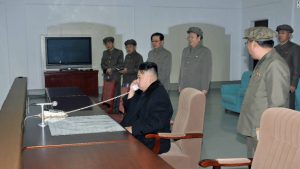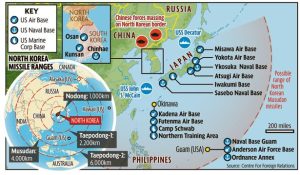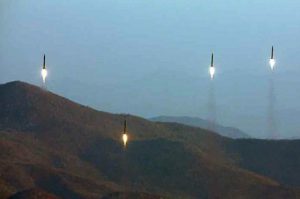
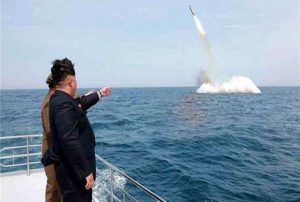
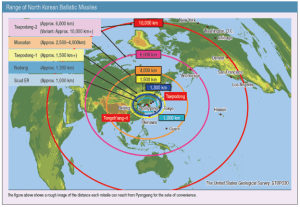
Confronting North Korea by changing the dynamics.
Withdrawing U.S. military dependents from the South would signal seriousness
By James A. Lyons, Admiral USN (ret).
ANALYSIS/OPINION:
On July 4, North Korea successfully test-fired the equivalent of an intercontinental ballistic missile with the potential to hit not only our regional allies but Alaska as well. Leading up to the latest test, President Trump, regrettably, has followed the path of the five previous administrations, believing that cozying up to China’s communist government would be helpful in reining in North Korea’s nuclear weapons program. By now, everyone should understand that will never happen. Let’s be clear: There would be no North Korean nuclear weapons program if it were not for China and Russia. Further, North Korea is the off-site laboratory and test site for Iran’s nuclear program.
Relying on China to rein in North Korea’s nuclear program has not only been a dismal failure, but a serious strategic mistake. Mr. Trump needs to stop listening to the Obama holdovers and other “undercover agents” for strategic advice. We should certainly understand by now that China’s strategic objectives include a nuclear-armed North Koreaas a way to lessen U.S. influence not only in South Korea but, ultimately, throughout the Western Pacific. Never forget — China is seeking total hegemony throughout the first island chain, which includes Taiwan and, eventually, the second island chain, which includes Guam, our main support base.
With those clear objectives, China is not about to hand us a victory on the Korean Peninsula without strong actions on our part. The fact that North Korea’s latest missile test was fired from a 16-wheel, road-mobile, transporter-erector-launcher supplied by China should have been particularly galling to Mr. Trump. According to Japanese reports, there are eight China-supplied launchers in North Korea. To rub salt in the wound, both China and Russia issued a joint statement on the day of the North Korean test, proposing to resolve the problem by having North Korea freeze its nuclear and ballistic missile testing (no dismantlement), provided the United States abandons large-scale joint exercises with South Korea.
There is simply no equivalence here. These defensive exercises have been a key component of maintaining peace and stability for the past 50 years. Why would we change? Ending these exercises has been a long-term China objective, which Beijing knows is a non-starter. Further, the fact that both China and Russia were able to issue a joint statement on the day of the test indicates that they most likely had advance notification.
On July 6, left-wing, newly elected South Korean President Moon Jae-in, following up on his campaign rhetoric, proposed more dialogue with North Korea and said that he is prepared to meet Kim Jong-un, the North Korean leader. He also extended an olive branch by calling for more economic cooperation and a resumption of family reunions. Regrettably, Mr. Moon doesn’t get it: You don’t reward a totalitarian regime for bad behavior. As we have seen many times, such conciliatory gestures are viewed only as a sign of weakness.
According to a July 7 Wall Street Journal article, the Trump administration plans to give diplomacy and economic sanctions more time to resolve the crisis with North Korea. With China, Russia and Iran ignoring the economic sanctions, though, there will be no change in North Korea’s violation of U.N. sanctions. When speaking in Warsaw with Polish President Andrzej Duda, however, Mr. Trump stated that he was considering “some pretty severe things,” which certainly could imply military action. Previously, the president has stated that since China has failed to help solve the problem, we will have to do it ourselves.
As we have seen over the years, successful diplomacy must have strong, recognized military options. It was “peace through strength” that was key to winning the Cold War against the Soviet Union. Under the current circumstances, without a dramatic change in the dynamics controlling the crisis with North Korea, more diplomatic discussions and potential talks with North Korea like the previous Six Party Talks, will also fail.
To put substance into our past declarations that “all options are being considered,” a dramatic, dynamic change must be introduced into the Korean equation. Accordingly, it is proposed that we plan to withdraw all U.S. military dependents from South Korea. This will not only remove a “hostage force” from the South Korean environment, but would also upset both China and North Korea’s calculations on what further actions are we planning to take. Certainly, it would provide us the freedom to plan a range of military options.
During the time it would take to remove all U.S. military dependents from South Korea, we should begin to massively reinforce our forces in the Western Pacific. This should include two or three attack carrier strike groups as well as four Air Force bomber squadrons, and up to 24 fighter squadrons with accompanying support forces. We should also plan to reintroduce tactical nuclear weapons into South Korea as well as on our forward-deployed submarines. A crash program to provide cruise-missile arsenal ships should also be part of the buildup.
Coordination with our allies will need to be factored into our overall planning. In that sense, an expanded military equipment package for Taiwan should also be planned. The unambiguous message that we would be sending is that we will not accept a nuclear-armed North Korea. It must dismantle its nuclear program or be destroyed.
- James A. Lyons, U.S. Navy retired admiral, was commander-in-chief of the U.S. Pacific Fleet and senior U.S. military representative to the United Nations.
